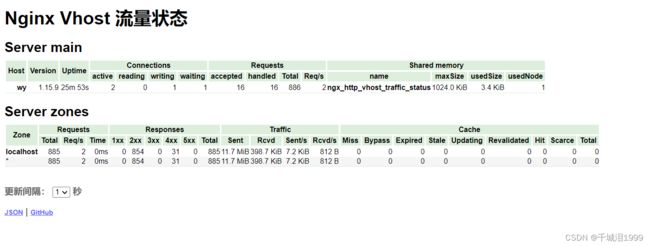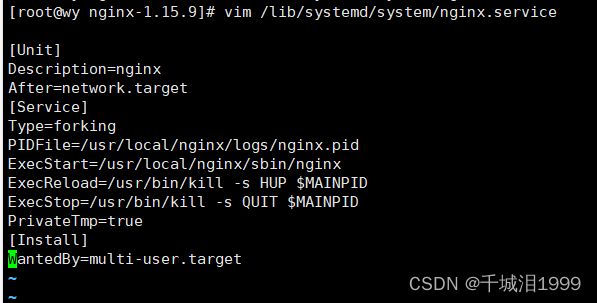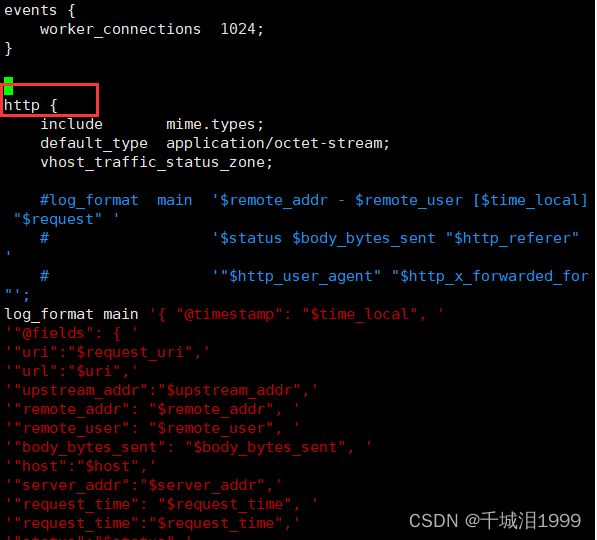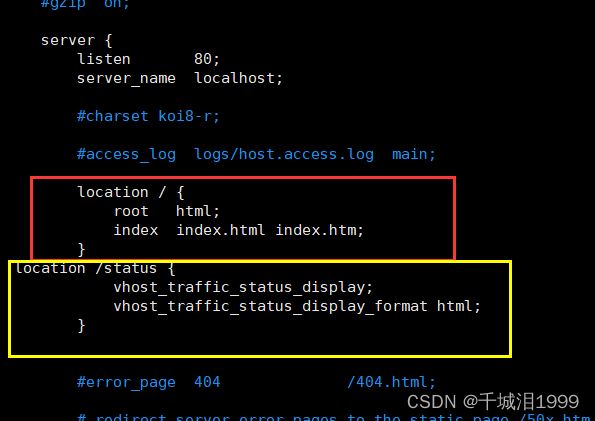nginx-vts监控模块
提示:文章写完后,目录可以自动生成,如何生成可参考右边的帮助文档
文章目录
- 一、Nginx 监控模块简介
- 二、Nginx 监控模块安装
-
-
-
- 1.关闭防火墙与核心防护
- 2.上传nginx-module-vst-master软件包到/opt目录下并解压
- 3.安装Nginx依赖环境
- 4.创建运行用户
- 5.编译安装nginx
- 6.优化管理
- 7.添加nginx系统服务
- 8.检查开启的模块
- 9.修改配置文件
- 10.查看nginx配置文件
- 11.重启nginx
- 12.访问测试
- 13.监控列表各项信息
-
-
一、Nginx 监控模块简介
监控Nginx主要用到以下三个模块:
1、nginx-module-vts:Nginx virtual host traffic status module,Nginx的监控模块,能够提供JSON格式的数据产出。
2、nginx-vts-exporter:Simple server that scrapes Nginx vts stats and exports them via HTTP for Prometheus consumption。主要用于收集Nginx的监控数据,并给Prometheus提供监控接口,默认端口号9913。
3、Prometheus:监控Nginx-vts-exporter提供的Nginx数据,并存储在时序数据库中,可以使用PromQL对时序数据进行查询和聚合。
二、Nginx 监控模块安装
1.关闭防火墙与核心防护
systemctl stop firewalld.service
setenforce 0
2.上传nginx-module-vst-master软件包到/opt目录下并解压
上传nginx-1.15.9.tar.gz软件包到/opt目录下并解压
将解压后的vst目录移动到/usr/local/
tar zxvf nginx-1.15.9.tar.gz
unzip nginx-module-vts-master.zip
mv nginx-module-vts-master /usr/local/
3.安装Nginx依赖环境
yum -y install gcc gcc-c++ pcre pcre-devel zlib zlib-devel openssl openssl-devel make
4.创建运行用户
useradd -M -s /sbin/nologon nginx
5.编译安装nginx
cd nginx-1.15.9
./configure \
> --prefix=/usr/local/nginx \
> --user=nginx \
> --group=nginx \
> --add-module=/usr/local/nginx-module-vts-master/
make && make install
6.优化管理
ln -s /usr/local/nginx/sbin/nginx /usr/local/sbin
或cp -a /usr/local/nginx/sbin/nginx /usr/local/sbin
ls -l /usr/local/sbin/nginx 查看软连接
写入脚本最好使用cp
让系统识别nginx的操作命令
以便管理员
直接执行“nginx”命令就可以调用 Nginx 的主程序
7.添加nginx系统服务
vim /lib/systemd/system/nginx.service
[Unit]
Description=nginx
After=network.target
[Service]
Type=forking
PIDFile=/usr/local/nginx/logs/nginx.pid
ExecStart=/usr/local/nginx/sbin/nginx
ExecReload=/usr/bin/kill -s HUP $MAINPID
ExecStop=/usr/bin/kill -s QUIT $MAINPID
PrivateTmp=true
[Install]
WantedBy=multi-user.target
chmod 754 /lib/systemd/system/nginx.service
8.检查开启的模块
nginx -V
nginx -t
9.修改配置文件
主要是修改默认日志文件格式,添加压缩配置,添加监控配置,具体可根据自己的需求修改
cd /usr/local/nginx/conf/
vim nginx.conf
vhost_traffic_status_zone;


开启此功能,在Nginx配置有多个server_name的情况下,会根据不同的server_name进行流量的统计,否则默认会把流量全部计算到第一个server_name上。
假如nginx没有规范配置server_name或者无需进行监控的server上,那么建议在此vhost上禁用统计监控功能。否则会出现“127.0.0.1”,hostname等的域名监控信息
在http { 下插入以下内容
log_format main '{ "@timestamp": "$time_local", '
'"@fields": { '
'"uri":"$request_uri",'
'"url":"$uri",'
'"upstream_addr":"$upstream_addr",'
'"remote_addr": "$remote_addr", '
'"remote_user": "$remote_user", '
'"body_bytes_sent": "$body_bytes_sent", '
'"host":"$host",'
'"server_addr":"$server_addr",'
'"request_time": "$request_time", '
'"request_time":"$request_time",'
'"status":"$status",'
'"request": "$request", '
'"request_method": "$request_method", '
'"size":$body_bytes_sent,'
'"upstream_time":"$upstream_response_time"'
'"http_referrer": "$http_referer", '
'"body_bytes_sent":"$body_bytes_sent", '
'"http_x_forwarded_for": "$http_x_forwarded_for", '
'"http_user_agent": "$http_user_agent" } }';
#log_format main '$remote_addr - $remote_user [$time_local] "$request" '
# '$status $body_bytes_sent "$http_referer" '
# '"$http_user_agent" "$http_x_forwarded_for"';
#access_log logs/access.log main;
sendfile on;
location /status {
vhost_traffic_status_display;
vhost_traffic_status_display_format html;
}
10.查看nginx配置文件
nginx -t
11.重启nginx
systemctl start nginx
12.访问测试
游览器中输入http://IP,看看nginx服务能不能正常启动
换上配置nginx服务器的IP

http://IP/status
换上配置nginx服务器的IP


在页面的最下方可以指定监控页面刷新的时间间隔,点击JSON,可以转为JSON格式输出。
13.监控列表各项信息
Server main 主服务器
Host:主机名
Version:版本号
Uptime:服务器运行时间
Connections active:当前客户端的连接数 reading:读取客户端连接的总数 writing:写入客户端连接的总数
Requsts accepted:接收客户端的连接总数 handled:已处理客户端的连接总数 Total:请求总数 Req/s:每秒请求的数量
Shared memory:共享内存 name:配置中指定的共享内存名称 maxSize:配置中指定的共享内存的最大限制 usedSize:共享内存的当前大小 usedNode:共享内存中当前使用的节点数
Server zones 服务器区域
zone: 当前区域
Requests Total:请求总数 Req/s:每秒请求数 time:时间
Responses:状态码数量 1xx、2xx、3xx、4xx、5xx 表示响应不同状态码数量 Total:响应状态码的总数
Traffic表示流量 Sent:发送的流量 Rcvd:接收的流量 Sent/s:每秒发送的流量 Rcvd/s:每秒接收的流量
Cache表示缓存 Miss:未命中的缓存数 Bypass:避开的缓存数 Expirde:过期的缓存数 Stale:生效的缓存数 Updating:缓存更新的次数 Revalidated:重新验证的缓存书 Hit:缓存命中数 Scarce:未达缓存要求的请求次数Total:总数











